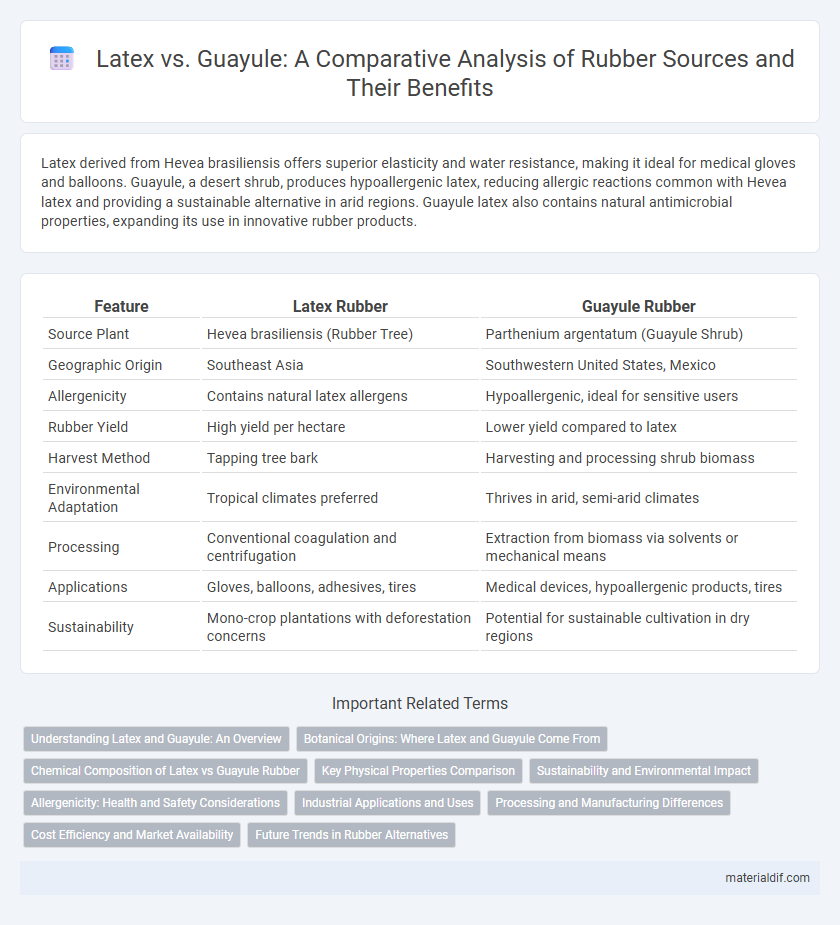Latex derived from Hevea brasiliensis offers superior elasticity and water resistance, making it ideal for medical gloves and balloons. Guayule, a desert shrub, produces hypoallergenic latex, reducing allergic reactions common with Hevea latex and providing a sustainable alternative in arid regions. Guayule latex also contains natural antimicrobial properties, expanding its use in innovative rubber products.
Table of Comparison
| Feature | Latex Rubber | Guayule Rubber |
|---|---|---|
| Source Plant | Hevea brasiliensis (Rubber Tree) | Parthenium argentatum (Guayule Shrub) |
| Geographic Origin | Southeast Asia | Southwestern United States, Mexico |
| Allergenicity | Contains natural latex allergens | Hypoallergenic, ideal for sensitive users |
| Rubber Yield | High yield per hectare | Lower yield compared to latex |
| Harvest Method | Tapping tree bark | Harvesting and processing shrub biomass |
| Environmental Adaptation | Tropical climates preferred | Thrives in arid, semi-arid climates |
| Processing | Conventional coagulation and centrifugation | Extraction from biomass via solvents or mechanical means |
| Applications | Gloves, balloons, adhesives, tires | Medical devices, hypoallergenic products, tires |
| Sustainability | Mono-crop plantations with deforestation concerns | Potential for sustainable cultivation in dry regions |
Understanding Latex and Guayule: An Overview
Latex is a natural rubber harvested primarily from the Hevea brasiliensis tree, known for its high elasticity and widespread use in gloves, balloons, and medical supplies. Guayule, a desert shrub native to the southwestern United States and Mexico, produces hypoallergenic rubber latex that serves as a sustainable alternative free from the proteins causing latex allergies. Both latex and guayule offer valuable sources of natural rubber, with guayule gaining attention for its drought resistance and potential in eco-friendly rubber production.
Botanical Origins: Where Latex and Guayule Come From
Latex is primarily harvested from Hevea brasiliensis, a tropical rubber tree native to the Amazon rainforest, while guayule (Parthenium argentatum) is a desert shrub native to the southwestern United States and northern Mexico. Hevea brasiliensis produces a milky sap rich in cis-1,4-polyisoprene, the key component of natural rubber, whereas guayule accumulates rubber particles within its parenchyma cells. The distinct botanical origins influence cultivation practices, climates suitable for growth, and the chemical composition of the extracted rubber.
Chemical Composition of Latex vs Guayule Rubber
Latex derived from Hevea brasiliensis predominantly contains cis-1,4-polyisoprene with high molecular weight and minimal protein content, contributing to its superior elasticity and resilience. Guayule rubber, sourced from Parthenium argentatum, exhibits a similar polyisoprene backbone but contains higher levels of resin, waxes, and non-isoprene components, influencing its lower purity and altered mechanical properties. The differential chemical composition of latex and guayule rubber affects their allergenic potential, processing methods, and suitability for hypoallergenic medical products.
Key Physical Properties Comparison
Latex from Hevea brasiliensis offers high elasticity and tensile strength, making it ideal for flexible, durable products, while guayule latex provides hypoallergenic qualities and moderate elasticity suitable for sensitive applications. Guayule's rubber exhibits lower protein content, reducing allergenic risk, and displays comparable resilience but slightly reduced elongation at break compared to Hevea latex. Both sources yield natural rubber with distinct molecular weights and viscosity profiles, influencing processing behavior and final material performance.
Sustainability and Environmental Impact
Latex derived from Hevea brasiliensis trees poses challenges such as deforestation and biodiversity loss, whereas guayule, a desert shrub native to the southwestern United States and Mexico, offers a more sustainable rubber alternative with lower water and pesticide requirements. Guayule's cultivation improves soil health and reduces carbon emissions compared to traditional rubber plantations, promoting environmental resilience. Shifting to guayule latex supports sustainable agriculture by minimizing ecological footprints and reducing reliance on tropical rubber sources vulnerable to climate change.
Allergenicity: Health and Safety Considerations
Latex from Hevea brasiliensis contains proteins responsible for allergic reactions in sensitive individuals, posing significant health risks in medical and consumer products. Guayule, a natural rubber alternative derived from Parthenium argentatum, offers hypoallergenic properties due to its negligible protein content, making it safer for people with latex allergies. Understanding the allergenicity differences is crucial for developing safer rubber products and reducing occupational exposure risks.
Industrial Applications and Uses
Latex derived from Hevea brasiliensis is widely used in industrial applications such as medical gloves, adhesives, and elastic materials due to its superior elasticity and tensile strength. Guayule latex, extracted from the desert shrub Parthenium argentatum, offers hypoallergenic properties and is increasingly favored for medical products and eco-friendly alternatives in automotive parts and ball bladders. While Hevea latex dominates the global market, Guayule's drought tolerance and renewable nature provide sustainable options for specialized industrial uses.
Processing and Manufacturing Differences
Latex derived from Hevea brasiliensis requires coagulation, centrifugation, and drying to produce natural rubber, whereas guayule rubber extraction involves solvent or mechanical processes to separate rubber particles from plant biomass. Hevea latex processing emphasizes stability and purity through ammonia stabilization, while guayule's hypoallergenic rubber offers a solvent-intensive extraction that yields distinct resin and rubber fractions. Manufacturing with Hevea rubber suits traditional latex products, whereas guayule rubber's compatibility with synthetic blends targets hypoallergenic medical and automotive applications.
Cost Efficiency and Market Availability
Latex from Hevea brasiliensis remains the most cost-efficient rubber source due to established large-scale plantations and global supply chains, resulting in lower production costs and higher market availability. Guayule latex, derived from the desert shrub Parthenium argentatum, offers hypoallergenic properties but currently faces higher extraction costs and limited commercial-scale production, restricting its market penetration. Efforts to improve guayule cultivation and processing aim to enhance cost efficiency and expand availability, targeting niche markets where latex allergies are a concern.
Future Trends in Rubber Alternatives
Guayule rubber, a hypoallergenic and drought-resistant alternative to Hevea latex, is gaining attention for sustainable production amid growing environmental concerns. Advances in biotechnology and genetic engineering are enhancing guayule yield and quality, making it a viable substitute in medical and industrial applications. Market trends indicate increased investment in guayule cultivation to meet rising demand for eco-friendly, domestically sourced natural rubber alternatives.
Latex vs Guayule Infographic

 materialdif.com
materialdif.com